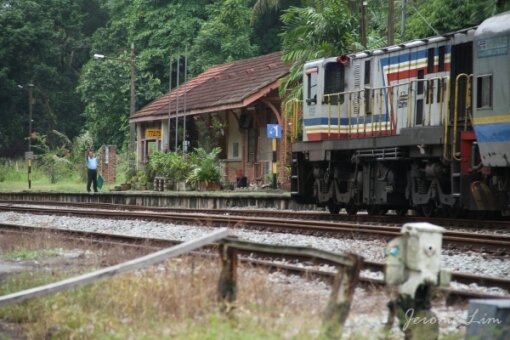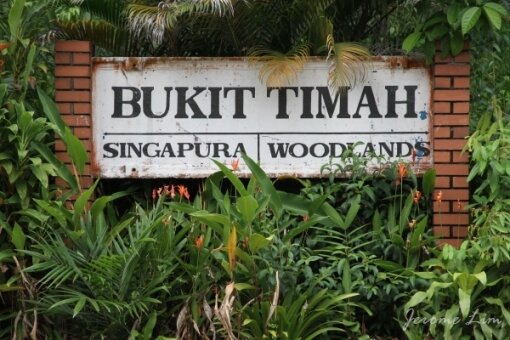Keeping Track of Time
Bridges, factories, fire stations, rural land – let’s take one more train ride along the Malayan Railway line that runs through Singapore.

A train passing Bukit Timah Station.
My earliest impressions of the Malayan Railway were formed perhaps not so much by the station at Tanjong Pagar, but by the two black steel truss railway bridges that seem to give the area of Bukit Timah that they cross its character. I often passed under the bridges as a child, seated in the backseat of my father’s car on the many trips he took us on to and from the Causeway and to Jurong, or to the Teck Whye area to visit a friend of my mother’s who ran an orchid farm.
Each time I passed under, my attention would be drawn to the heavy steel trusses, sometimes hoping that I could see a train traversing one of them. The bridges would serve as a landmark for me on the long road journeys from the Causeway. The stretch from the Causeway down the Woodlands and Bukit Timah Roads always seemed endless, particularly having had been seated in the backseat for a large portion of the journey along the winding roads north of the Causeway, taking us past the monosodium glutamate processing ponds close to the Causeway and the Metal Box factory, then Bukit Panjang Circus and Bukit Gombak, and further on past Boys Town before the first of the two black bridges came into view.
Seeing the first meant that the long and boring part of the journey would be coming to its end, and I could look forward to seeing the Hume Factory, Ford Factory, and Magnolia Dairies on the hill, before the Bukit Timah Fire Station came into sight and with it, the huge Green Spot bottle at the entrance of the Amoy Canning Factory that I would never fail to look out for.

One of the two steel truss bridges that give the Bukit Timah area its distinct character.
Passing under the bridges and catching an occasional glimpse of a train on one of them would also bring with it a desire to make a train journey of my own, something that I only managed to do later in life. When I did finally embark on that very first train journey and on my subsequent journeys, I did find that there was a lot more than the bridges that captivated me. The train rides always provided an opportunity to catch a glimpse of a Singapore that would otherwise remain hidden to me, with the route that the train takes meandering through parts of Singapore that could very well be in another world.
Two spots came to my attention on that first ride, having been provided with a good glimpse of them from the unscheduled stops that the train made prior to reaching the Causeway. The two were a short distance apart, on either side of the first of the railway bridges that cross Bukit Timah Road, the first being at the Bukit Timah Station just before the bridge, a station that I had hitherto not known about, and the second just after the bridge – at the stretch just behind the Yeo Hiap Seng factory.

A southbound train crossing the bridge near the site of the former Yeo Hiap Seng factory.

The trains to and from Tanjong Pagar take a route through some untouched parts of Singapore.
Having caught a good look at Bukit Timah Station that very first time in the dim illumination it was provided with, I was fascinated, seeking to find out more about it when I got back to Singapore. From what I could see of it, it had looked to me like one of the little rural stations that might have depicted in one of the Ladybird books that I had spent my early years reading, one that could be one used to model a miniature station for one of those model train sets that I had often looked longingly at in the toy department of Robinson’s. It was in future train journeys in the daylight that I would get a better glimpse of it, being something that I would never tire looking out for on all my journeys by train.

Bukit Timah Station is a little known about station in Singapore, off Bukit Timah Road.

Bukit Timah Station could pass off for one of the little stations on a model train set.
The station, I was to learn, was built in 1932 as part of a realignment of the original railway line which had run from Woodlands down to its terminal at Tank Road via Newton Circus. The realignment or “deviation” as it was referred to then, was carried out at considerable expense at the end of the 1920s, partly motivated by the need to elevate certain portions of the track as the old line had been prone to being overrun by the frequent floods that afflicted the low-lying Bukit Timah corridor the line ran through, and at the same time allowing what were considered to be dangerous level crossings to be minimised.

















